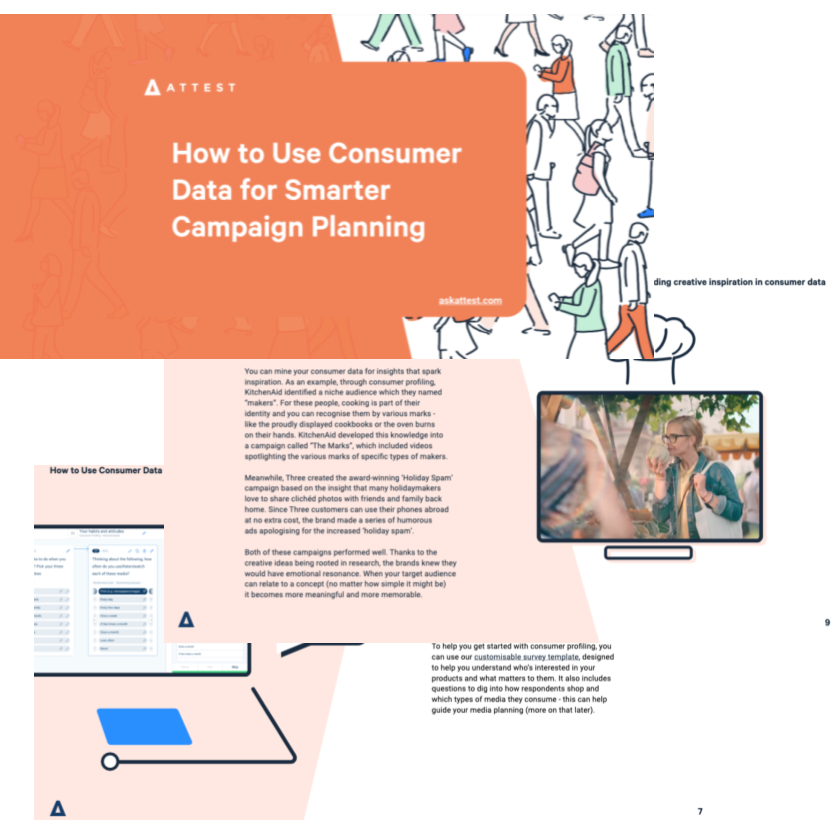7 creative ways to instantly improve your campaign planning

About to start planning a new marketing campaign? We’re going to show you 7 techniques to make it your best yet.
About to start planning a new marketing campaign? We’re going to show you 7 techniques to make it your best yet.
You’ll see how consumer survey data can give your process a quick shake up and transform your outputs. These are methods used by our clients: top marketers at consumer brands like Boots Walgreens, Transferwise, Gymshark and Tommee Tippee. Learn how you can use them too!
1. COVID consumer check-in
Coronavirus has changed us all – that’s why it’s important to check in with your target consumers before your next campaign. Since the start of the pandemic, our clients have been busy running consumer profiling surveys and making discoveries around changed habits, preferences and attitudes. This has allowed them to keep their marketing personas up-to-date and their messaging on point.
2. Test draft concepts
You don’t have to wait until you have perfectly polished creative to test it with an audience. You can improve your process by bringing in consumer opinion much earlier on. Once you have a few draft creative concepts you can test them to see which people prefer (it’s easy with our creative testing survey template). Integrate mock-ups, storyboards or rough edits into your surveys and proceed with only your strongest concept(s). Meanwhile, weaker ideas get left on the cutting room floor before you’ve spent money developing them.
3. Perform iterative creative testing
Another tactic used by top marketers is creative asset optimisation. After an ad has been created, they make tweaks to improve its performance, just like an engineering team working on an F1 car. Using baseline measurements of KPIs like brand recognition and purchase intent, they can run experiments to see how metrics are affected by changing different ad elements. They can A/B test things like the call to action, tagline, or logo placement to see which get the best results (learn how to get started with iterative creative testing).
4. Plan media dynamically
This is one of the simplest ways to give your campaign planning a big boost and it’s made possible by Attest’s super speedy survey completion times. Because you can get responses in minutes, you can use real-time data to plan where and when you want your ads to appear. Simply ask your target audience what TV shows they plan to tune into this week or which podcasts they can’t get enough of right now, and book your ads accordingly. It’s a surefire way to get your ads in front of the right audience.
5. Put out a PR piece
Generating buzz around your campaign is a great way to amplify its effectiveness – just look at how excited people get about John Lewis’s annual Christmas ads. While you might not be releasing a festive blockbuster, you can still win column inches for your campaign by putting out a quirky PR piece. This is much easier to do when your campaign is based on consumer insight – just share the interesting data that inspired the creative. Perhaps you found that people are 10x more likely to holiday at home this half term or that pet-owners returning to work after lockdown are experiencing separation anxiety. Whatever it is, there’s a story in it!
6. Take some alternative ROI measurements
Proving return on investment when it comes to marketing campaigns is important for getting your budget and strategy signed-off internally. Show the true value of your campaign by going beyond traditional metrics like return on ad spend (ROAS) and impressions to look at the effect it had on brand building. Did the campaign increase unprompted/prompted brand awareness? Did it change your Net Promoter Score (NPS) or make people more likely to buy your brand? Use our campaign tracking template to take pre and post-campaign measurements.
7. Check your competition
Here’s another little trick for earning brownie points in the boardroom and increasing buy-in for your next campaign; show how you’re beating the competition. It’s done by taking the brand health measurements of your closest competitors (there’s nothing to stop you) and then comparing them to your own. For example, you can find out your rival’s net promoter or brand awareness scores to benchmark against. Or, why not directly compare your campaigns to find out which one the public preferred? We do it every week with our #AdTestFriday feature.
Excited to see how these 7 techniques could boost your campaign planning? Learn more about using consumer data to elevate your marketing in our free guide…
Tell us what you think of this article by leaving a comment on LinkedIn.
Or share it on:

